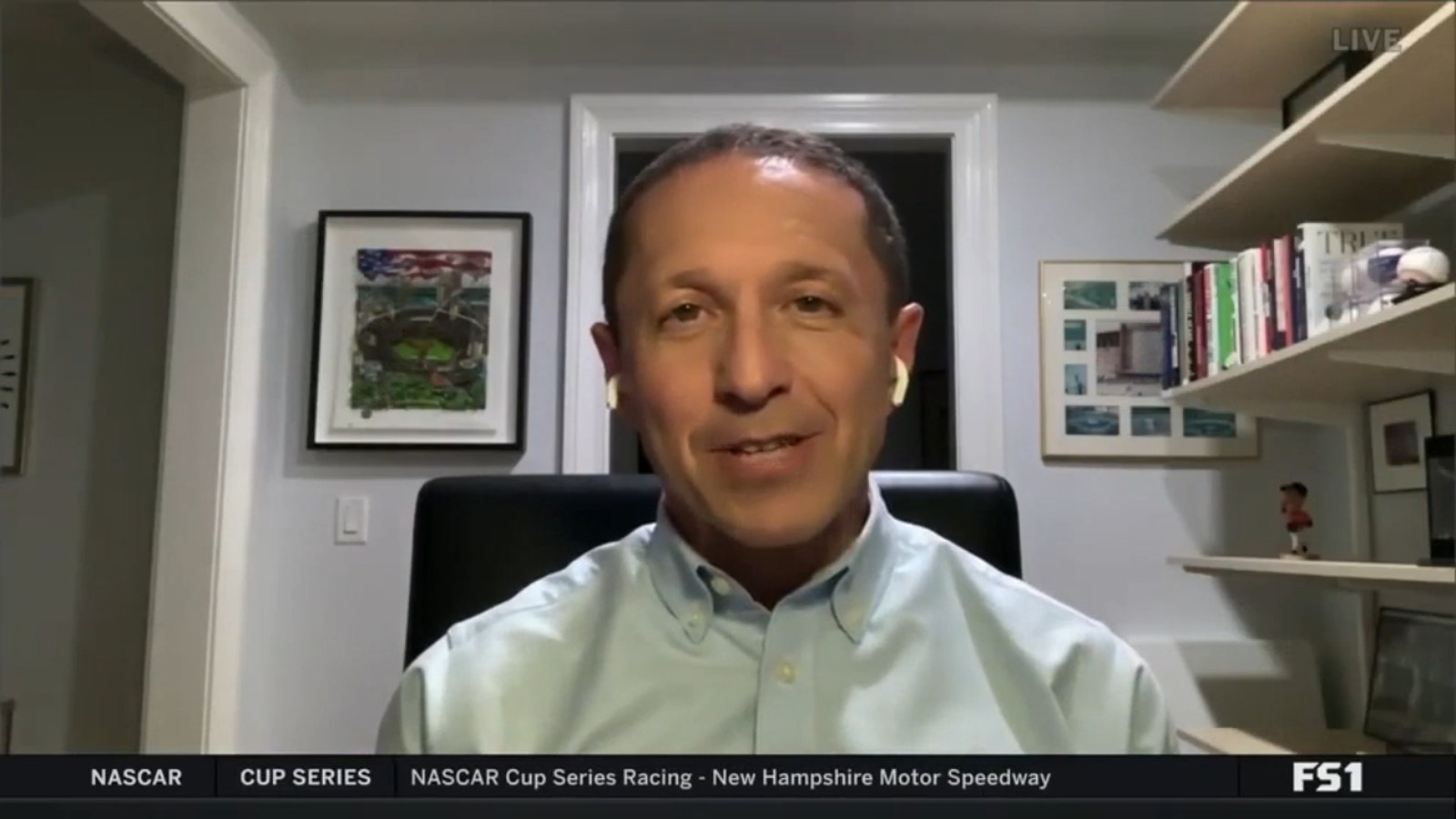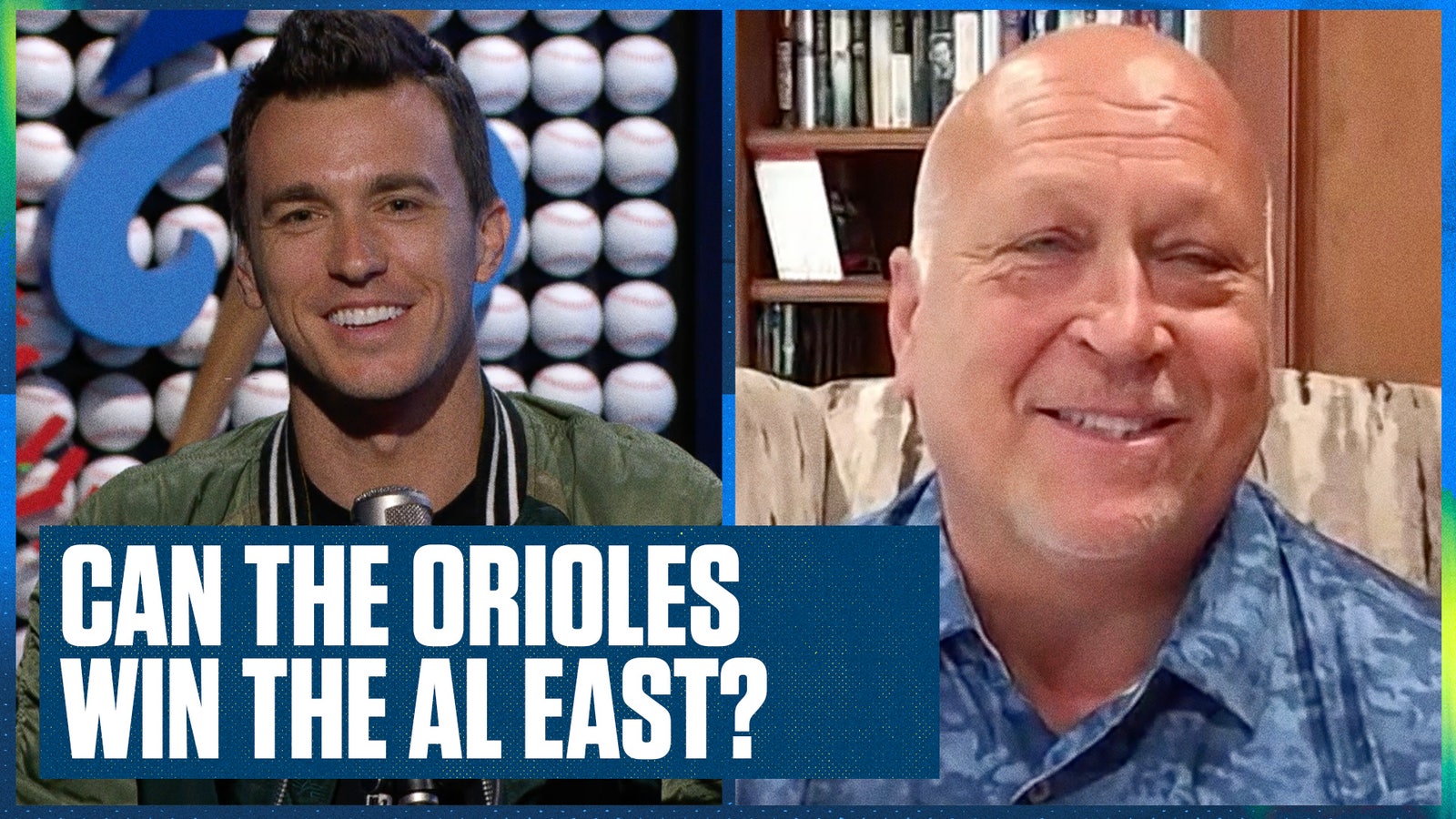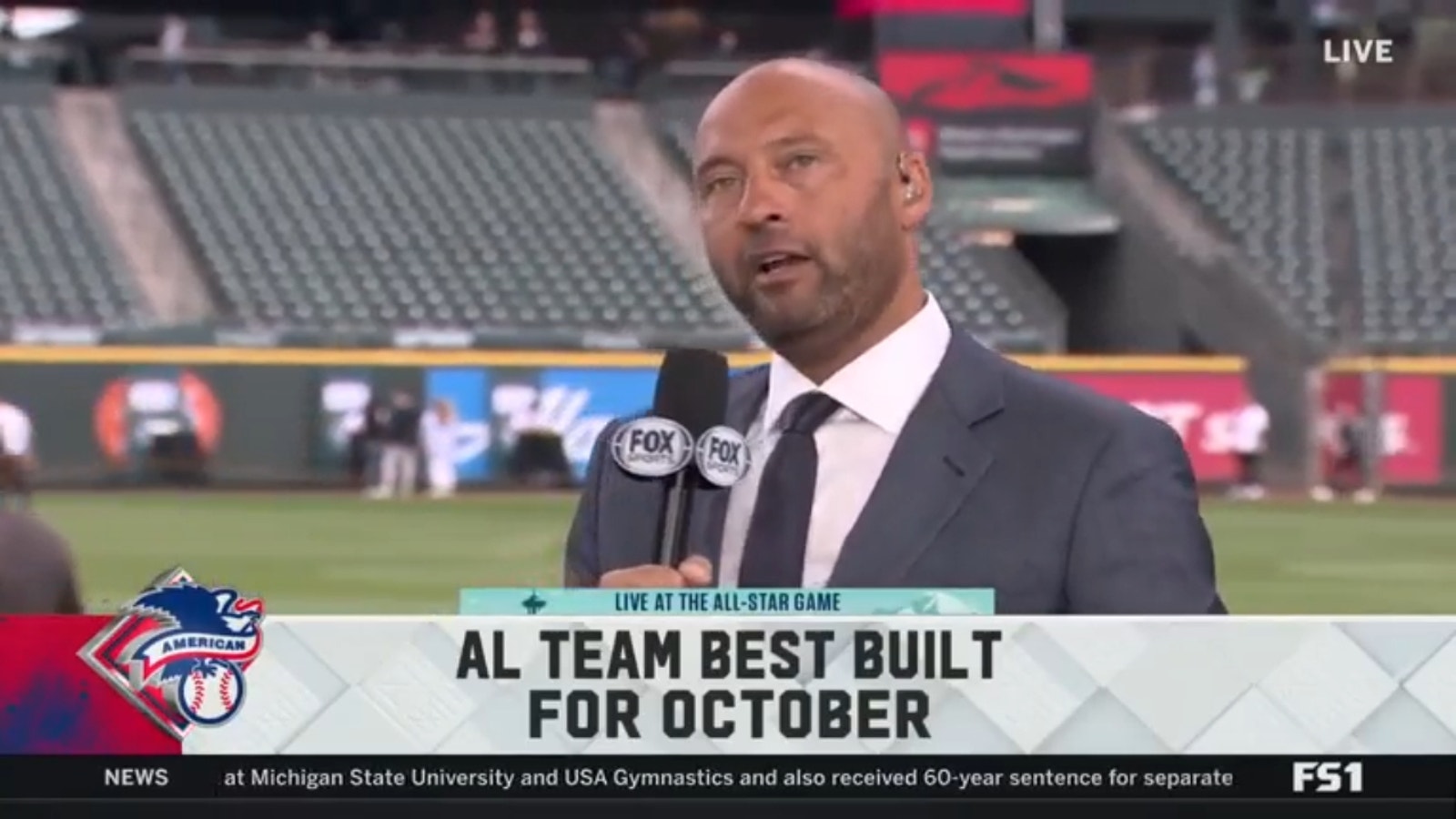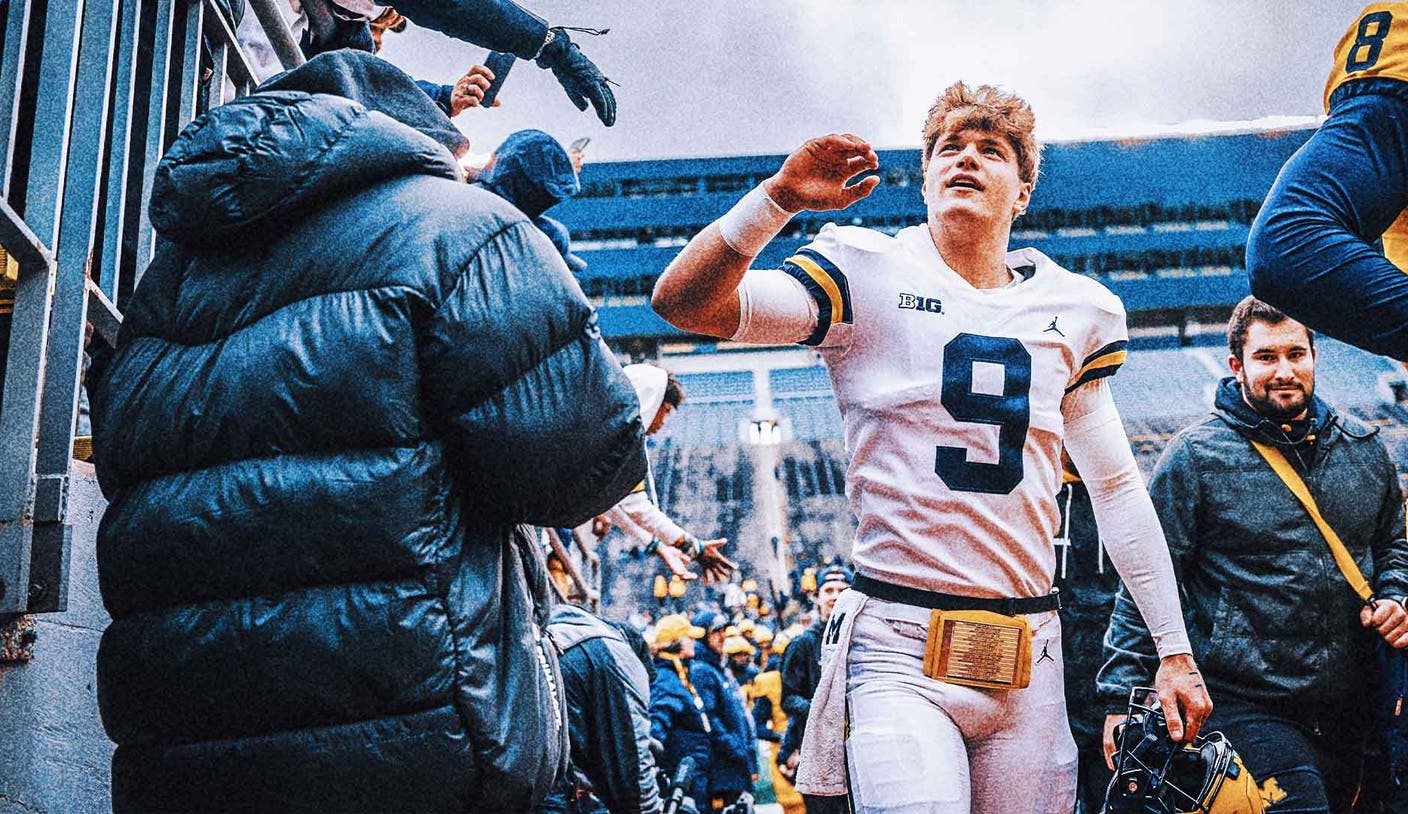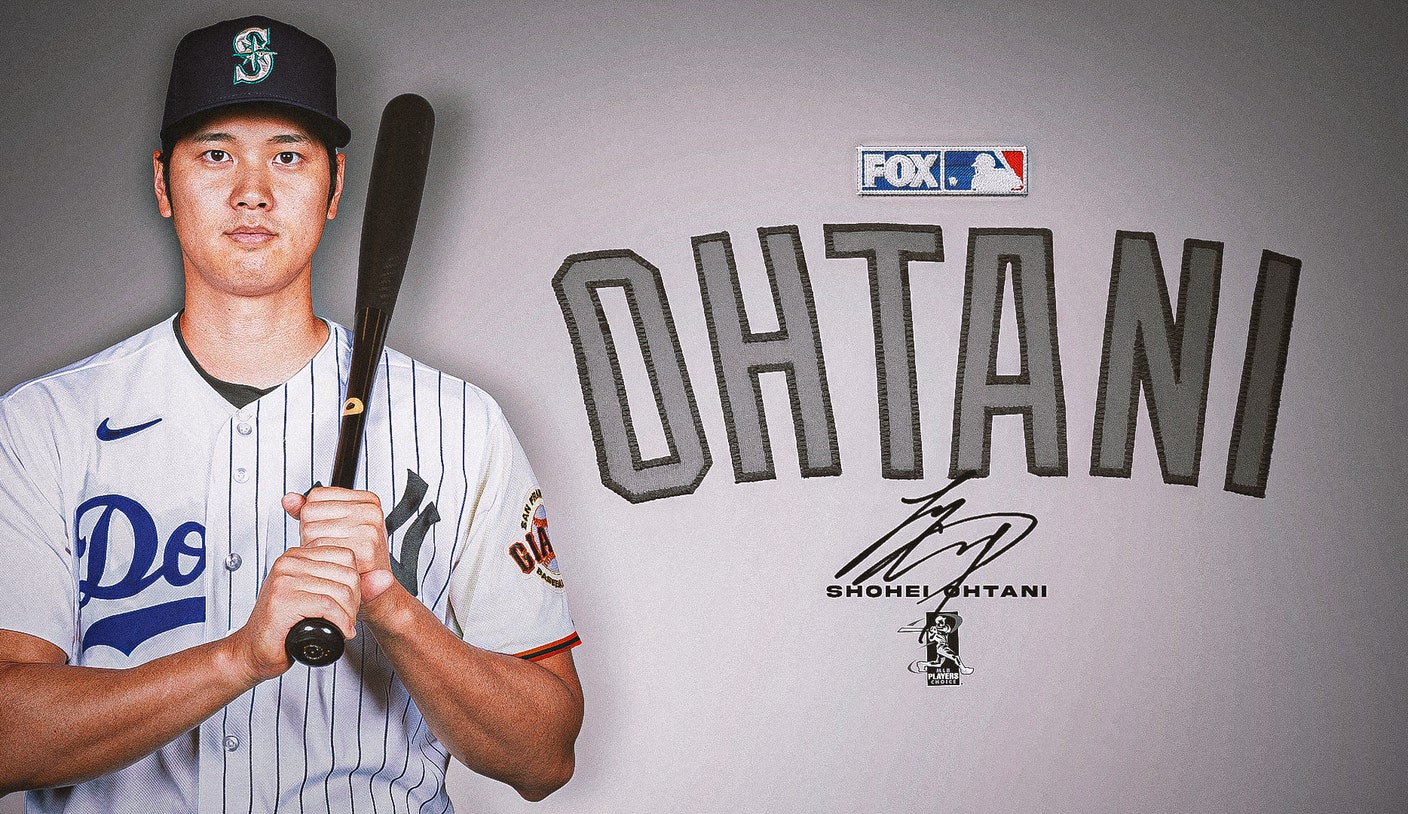
Shohei Ohtani’s upcoming free agency will be unlike anything we’ve ever seen in baseball — or arguably any sport. But with the Angels once again floundering on the outskirts of the AL postseason picture, an even more chaotic scenario has presented itself as a delicious appetizer to this winter’s madness: an Ohtani trade.
This would indisputably be exiting the rational bounds of standard trade negotiations. Moving the most talented player the game has ever seen takes this discussion to a totally different stratosphere, far beyond our basic understanding of trade value and roster construction. These discussions in the coming weeks will involve the highest-ranking people in every organization — the owners, of course — injecting an element of unpredictability and making it extra challenging to project what a deal might look like.
With all that in mind, allow us to put our GM hats on and pretend we have the blessing of ownership to craft whatever Ohtani trade package somehow feels both responsible and realistic. To win a bidding war of this nature will probably require some recklessness — and the truth is, any fan base that successfully lands Ohtani will be beyond jubilant regardless of the cost.
But this exercise is about giving the Angels a package they can feel reasonably good about under the difficult circumstances, while also not completely mortgaging the future for an acquiring team not guaranteed to have Ohtani beyond these next few months.
Here we go.
Seattle Mariners: RHP Bryce Miller, SS Cole Young, RHP Emerson Hancock, OF Cade Marlowe, RHP Ashton Izzi
Mariner fans made their hopes and dreams quite clear during the All-Star Game at T-Mobile Park with their emphatic “Come To Seattle!” chants during Ohtani’s at-bats, and it’s safe to assume they’ll make a push for him this winter after coming up short in 2017. But amidst an underwhelming encore to their breakthrough 2022 campaign, does it make sense to push a ton of chips in for Ohtani via trade? That’s a fair question with an answer that should crystalize in the coming weeks. For the purposes of this exercise, though, let’s say Trader Jerry Dipoto is ready and eager to make a massive splash at the deadline, one that could make last summer’s Luis Castillo acquisition look like child’s play.
What Seattle does have to offer, more than almost any other team, is MLB-ready pitching with significant upside — and the rotation depth to withstand departing with one of those arms both amidst a potential postseason push this year and in the next few seasons should Ohtani find a new home after 2023.
There’s an argument to lead with George Kirby or Logan Gilbert in any of these discussions, but those two are such cornerstone members of a pitching staff slated to be a strength for a long time that it’d be tough to deal them away for any rental player. Bryan Woo or Bryce Miller, however, are two other talented young hurlers who have already shown well at the highest level; pitchers of this caliber with five-plus years of team control are VERY rarely attainable via trade. I’ll roll with Miller here but either works as a strong starting point for an Ohtani package.
Young, last year’s first-round pick — who is off to a great start in A-ball — would be tough to deal away so quickly but already feels more expendable considering the haul of high-school hitters the Mariners just reeled in this month’s draft. Hancock’s prospect shine may have dimmed somewhat since being selected sixth overall in 2020, but he’s a mature righty with a deep arsenal who can likely pitch in a big-league rotation by this time next year if not sooner.
Marlowe is a useful athletic outfield depth piece already performing well in Triple-A, while Izzi a projectable teenage right-hander with burgeoning velo and a good curveball.
It’s no secret how badly the Mariners and their fans want to see Ohtani in their home threads. But beyond the crucial question of whether this squad is even good enough to warrant being aggressive buyers at the deadline, how much would acquiring Ohtani now help in efforts to sign him long-tem this winter? The answer to that probably varies for each interested team, but Seattle would seem to be pretty high on the list of clubs who could benefit especially from making Ohtani feel at home over the next few months as a trial run for a longer-term commitment.
[Thosar: Could Shohei Ohtani break Aaron Judge’s AL home-run record one season later?]
San Diego Padres: OF Samuel Zavala, RHP Jairo Iriarte, LHP Jackson Wolf, RHP Ryan Bergert, OF Jakob Marsee, RHP Kevin Kopps
There’s no reason not to expect San Diego to pursue Ohtani as a free agent, but let’s say the Padres claw their way back into the postseason mix over the next couple weeks and put themselves in positions to be buyers at the deadline. Why not make the biggest trade in MLB history for the second summer in a row? That seems like something GM AJ Preller would love to add to his resume.
No team has shipped away a larger quantity of prospects — for better and for worse — than Preller in recent years, leaving the organizational depth chart in an intriguingly lopsided state. There are superstars at the top in the big leagues, and potential superstars at the lower levels of the minors, but very little depth in between. In turn, the biggest challenge for San Diego is the severe lack of young MLB-ready talent worth offering to an Angels team that would have to be targeting some level of certainty if willing to part with Ohtani.
However, if the Angels are actually more amenable to a longer-term rebuild without as much focus on staying competitive in the near future, San Diego does still have ample premier prospect capital to compile a strong offer.
The easiest path to a deal might be leading with shortstop prospect Jackson Merrill or 17-year-old phenom backstop Ethan Salas, but I’d assume Salas is completely untouchable and Merrill is close to it as well. Instead, let’s try to overwhelm Anaheim with a variety plate of lower-level upside plays, a diverse array of players on upward trajectories.
Zavala’s precocious offensive ability is more OBP, but he’s a center fielder who just turned 19 and performing as one of the youngest players in full-season ball. Iriarte might not be as famous as fellow Padres prospect arm Dylan Lesko — another potential headliner in a blockbuster deal like this — but he also has big-time potential with a fastball up to 100 and rapidly improving secondary stuff. He’s 21 and just reached Double-A. Wolf and Bergert were college teammates at West Virginia and are now both thriving in the Minors, with Wolf potentially being MLB-ready sometime in 2024.
Marsee is a speedy center fielder with strong OBP skills that has shown more power in pro ball than he did in college. And hey, let’s throw in a Golden Spikes Award winner while we’re at it — albeit one who’s probably a middle-reliever in Kopps.
It’s a whole lot of risk to take on when making a trade of this magnitude. At the same time, a package like this would allow the Angels more bites at the apple than going all-in for one or two super-duper high-end names. From San Diego’s perspective, it feels more palatable to deal from this kind of depth rather than risking giving away relatively higher-probability stars in Merrill or Salas.
Cincinnati Reds: INF/OF Spencer Steer, RHP Connor Phillips, 3B Sal Stewart, RHP Joe Boyle, INF Rece Hinds
Whether the Reds can win one of the more unexpected division titles in recent memory remains to be seen, but 2023 has been a massive step forward for this franchise regardless of the final outcome. The arrival of an unmatched wave of talented rookies headlined by Elly De La Cruz, Matt McLain, and Andrew Abbott is very exciting. That said, an ugly skid in recent weeks already has Cincinnati leaving a potential trade for Ohtani to appear more like a hail mary than a move that would “put them over the top” like some of the other teams on this list.
At the same time, a trade is the only way Ohtani would ever be wearing a Reds uniform, so this is the necessary route — a snowy visit to Great American Ball Park in December doesn’t seem likely to sway the generational superstar this winter, not to mention the unfamiliar cost associated with signing him.
What would it take to land Shohei in Cincy at the Deadline? The three aforementioned rookies would certainly be off limits, but the Reds have even more MLB-ready young talent available to offer beyond them. Steer might not be the flashiest headliner, but a 25-year-old who can play multiple positions and produce offensively to his degree is a tremendously valuable player. He’s exactly the kind of reliable foundational piece the Angels have failed to acquire or develop during the Trout/Ohtani era.
Phillips’ command is still a bit crude, but his raw stuff is some of the nastiest of any pitching prospect and he leads all MiLB pitchers in strikeouts; he’s close to big league-ready, too. Stewart, the 32nd overall pick in last year’s draft, has hit well in Low-A this season but is years away from the big leagues. Hinds (elite power, significant contact issues) and Boyle (huge stuff, not much idea where it’s going) are two high-upside lottery ticket throw-ins right up the Angels’ alley.
The Reds’ farm system is deep enough to absorb a hit like this. Even still, this package feels like a bit heavy to offer for a two-month fever dream that might not even be enough to reach the postseason. To make Shohei Ohtani a Red, though? This might be what it takes. — Jordan Shusterman
San Francisco Giants: CF Luis Matos, LHP Carson Whisenhunt, TWP Reggie Crawford, OF Wade Meckler, OF Heliot Ramos
The Giants are a fascinating Ohtani landing spot because they’re (1) currently competitive and (2) have money to spend this winter. After missing out on Aaron Judge and Carlos Correa last offseason, San Francisco should be in on the two-way dynamo’s free agent sweepstakes. Trading for him now would serve as part-rental, part-two-month sales pitch.
Still just 21 years old, Matos projects as a high-contact, tough-to-strike-out center fielder in the Brandon Nimmo mold. He’s not a future perennial MVP candidate and his surface-level big-league stats are underwhelming, but the swing decision and batted ball data is in line with Matos’ reputation and he’s a likely above average big leaguer under control for six more seasons. That’s valuable.
Whisenhunt was a 2022 first-round pick out of East Carolina who’s flown through the minors thanks to a dastardly good change-up and mid-90s heat from the left side. The slider is a work in progress, but if that comes around he’s a legit rotation piece on a competitive team.
Crawford is a two-way consolation prize. Drafted out of UConn a year ago, the 22-year-old might be the most intriguing pitcher/hitter currently in minor league baseball. Crawford’s developmental road will be long and he only recently returned from Tommy John rehab, but the upside is sky-high — and who knows how to handle two-way dudes better than Anaheim?
Meckler has obliterated minor league pitching this season despite his lack of power. He smells more like a Guardians prospect — awesome bat-to-ball and swing decision skills with no juice — but could become a legit guy if he (1) somehow grows into more power (2) improves his CF defense.
Ramos is a former top prospect who’s yo-yo’ed between Sacramento and San Fran a few times over the last few years, but hasn’t been able to get his footing with the big league club. He’s currently raking in Triple-A and would be a controllable big league ready buy-low piece for Anaheim, ala Mickey Moniak.
Phillies: SP Mick Abel, 2B Bryson Stott, IF Hao Yu-Lee, RHP Alex McFarlane, SS Bryan Rincon
Bryce Harper is reportedly going to start playing some first base this weekend, his first MLB foray into the infield. That’s relevant because Harper has only DHed since his elbow injury last spring. It also theoretically opens up a spot for Ohtani. It’s an unlikely landing spot considering the Phils probably don’t want Harper as their everyday 1B, but GM Dave Dombrowski is known for his aggression at the deadline.
Abel, who started the Futures Game for the National League a week ago, might be the best pitching prospect in the minor leagues right now. His fastball velocity has climbed steadily over the last few years and now sits in the 95-97 range, per FanGraphs. Pitching prospects are famously volatile and unreliable, but Abel, who has been one of the best pitchers his age dating back a half-decade, has a crystal-clean injury history and every chance to be a No. 2 MLB starter. This is the centerpiece.
The Angels would probably want a young, controllable big-league bat in exchange for Ohtani, which means Stott, whose lifelong relationship with Harper makes him a key cog in the Phillies clubhouse, gets roped into this deal. He slid over to second base this year for Trea Turner, but could move back to SS for Anaheim and is an improving, above-average hitter in his second big league season.
Lee, a 20-year-old infielder from Taiwan, boasts above average contact skills and burgeoning power for an undersized guy. Scouts agree that he’s probably not a shortstop long-term, but Lee’s bat has a chance to make him a big league regular.
McFarlane was a relief prospect with big gas who the Phillies have tried out as a starter. He’s racked up good numbers this year, but the velo is down a bit. He’s either a back-end rotation guy or a nice bullpen piece.
Rincon was a late-round Pennsylvania high school kid with defensive chops at short who has walked a lot and hit for a bit more power than expected in his first full season. Still at Low-A, he is a long-term project.
Orioles: IF Coby Mayo, OF Colton Cowser, OF Jud Fabian, IF Joey Ortiz, RHP Justin Armbruester, RHP Trace Bright
The O’s farm system is outrageously deep with hitters. Like, stupid deep — every website’s top 100 prospect list is dotted with a plethora of Baltimore bats. No farm system in baseball can offer a more enticing package than the Orioles. You can’t put 20 people in the lineup, no matter how good skipper Brandon Hyde is. And while this rotation has performed admirably, it’s sorely lacking a front-line soul-snatcher like Ohtani. With allllll that in mind, folks around the game are skeptical that GM Mike Elias, long considered one of the sport’s more conservative and long-view-minded head honchos, will push his prospect chips in for two months of any player.
Mayo just got promoted to Triple-A Norfolk after scorching Double-A pitchers to the tune of a 1.026 OPS. He’s a big boy, with an odd-looking swing and light-tower raw juice. Mayo has always hit and probably always will. If he sticks at third, the ceiling is Austin Riley with worse defense. If he moves to an outfield corner, 2021 Teoscar Hernandez with more walks is a fair comparison. Either way, he’s a real hitter.
Cowser is an interesting one. Drafted fifth overall by Batimore for the elite contact ability he showed in college, the outfielder has developed a lot more swing and miss as a pro. His discerning eye at the plate borders on overly passive but that profile still comes with a mountain of walks. Having already reached the bigs, Cowser can hack it in center field right now but is probably better suited for a corner spot in the long run.
Lets just go ahead and complete the outfield here with Fabian, a tooled-up CF with swing-and-miss issues. Fabian is currently rocking a 37% K rate in Double-A — big yikes — but has awesome power and is a lock to stick in center.
Ortiz was drafted out of New Mexico State as a glove-first shortstop, but then the Orioles’ magic hitting-development group got their hands on him and he’s turned into an offensive force in Triple-A over the last two seasons. He’s already made his big-league debut, will probably stick at short and is rocking a .947 OPS in Norfolk.
Armbruester is a back-end starter type who has outpitched his peripherals in all three of his minor-league seasons. There’s nothing particularly eye-popping about him, but the 6-4 righty is in the midst of another good statistical season.
Bright is walking too many hitters at High-A and might eventually move to the bullpen, but the Auburn product has a shot to become a strikeout heavy back-end arm. — Jake Mintz
Los Angeles Dodgers: RHP Emmet Sheehan, RHP Gavin Stone, INF Michael Busch, C Dalton Rushing, OF Andy Pages, RHP River Ryan
The Dodgers could offer most of their farm system to the Angels, and it might not be enough to convince Arte Moreno to deal the greatest player we’ve seen to the rivals up the 5 (even if that rivalry between Southern California foes is considerably overblown). But the Dodgers could reason that getting Ohtani now might give them some sort of leg up for the bigger decision looming this winter. Plus, they desperately need top-line rotation help at the deadline with Dustin May out for the year, and Ohtani provides the ace necessary to pair with Julio Urías and Clayton Kershaw to seriously compete for a championship.
They have wanted him for the past decade, and they might have the most attractive pieces of any team to make it a reality. Could they really pull it off without including Bobby Miller, who might still be needed in a shorthanded rotation that would have lost Sheehan in this deal? If there’s a team equipped to deal a bevy of prospects without decimating their system, while still offering the Angels the most upside of any package, it’s the Dodgers. This is the same team that managed to hold onto Gavin Lux through all the trades for Manny Machado, Mookie Betts, Trea Turner and Max Scherzer.
Unfortunately for them, one of their areas of surplus is at catcher, where the Angels won’t need a ton of help once Logan O’Hoppe returns. Rushing provides more defensive versatility than Diego Cartaya, which could also allow the Dodgers to keep their top overall prospect in this deal. The offer would have to be centered around the many pitching talents in the system. If the Angels like Nick Frasso, Nick Nastrini, Landon Knack, or Maddux Bruns considerably more than any of the originally proposed pitchers, that shouldn’t hold up the deal.
Adding Ohtani would make All-Star DH J.D. Martinez a somewhat superfluous piece, so the Dodgers could either hang onto him and try to play him at a corner outfield spot, include him in an Angels deal or flip him elsewhere for more pitching help. Considering how much Mookie Betts has enjoyed the reunion, the Dodgers might not want to lose that connection.
Toronto Blue Jays: LHP Ricky Tiedemann, INF Addison Barger, INF Santiago Espinal, RHP Yosver Zulueta, UT Otto Lopez
Is this the likeliest outcome? With a farm system universally ranked in baseball’s bottom half, as low as 24th by FanGraphs, probably not. It’s not just that the Blue Jays lack the trade pieces other teams can offer, but also that they’re not as well-equipped to replenish the losses as other teams would be. But is it at least feasible if Tiedemann is involved? Sure!
He is the only consensus top-100 prospect in Toronto’s system (FanGraphs also includes Barger, who is in this deal, as a top-60 guy), and while the Blue Jays don’t possess the top-level prospect capital of other contenders, they could still put together an enticing enough package that includes a combo of major-league ready talent and projectability to haul in a piece as dazzling as Ohtani. If Tiedemann is not involved, the Angels probably hang up.
Texas Rangers: RHP Jack Leiter, RHP Owen White, UT Ezequiel Durán, OF Aaron Zavala, IF Justin Foscue, RHP Emiliano Teodo
Is it time for the Rangers to go all in? And could they really do it while keeping top prospect Evan Carter? This might be an enticing enough package to get it done. To be sure, this is still parting with a ton of talent. The Angels would arguably be getting the top two pitching prospects in the system in White, who started the Futures Game and could help immediately, and Leiter, the former No. 2 overall pick who has run into some surprising command issues in pro ball but is striking out more than 11 batters per nine innings.
The presence of Ohtani in the lineup could make the Rangers more willing to part with Durán, whose utility skills, offensive breakout and team control through 2028 should make for an incredibly alluring piece. Foscue continues to rake at every level, but with Corey Seager and Marcus Semien manning the middle infield and Luisangel Acuña enjoying his own breakout in the system, he’s expendable.
The Rangers have shown a willingness to spend in the winter, but if there’s a time to push in all the chips and go for it, it’s right now. And with Jacob deGrom out for the year, Nathan Eovaldi could use an ace alongside him. — Rowan Kavner
New York Yankees: OF Jasson Domínguez, INF Oswald Peraza, OF Spencer Jones, INF Gleyber Torres
The Yankees are one of the many teams motivated to get Ohtani, and they may also be the most desperate. The organization with 27 championships has failed to win a title in the last 14 years and the Yankee fan base is past the point of impatience. GM Brian Cashman recently publicized the team’s needs, featuring a list so long it would stretch a CVS receipt. Despite the roster holes, a World Series ring is still very much on the table this year.
Their two most important needs include a big bat and starting pitching depth. Swinging a trade for Ohtani would solve both of the Yankees’ biggest problems on their win-now roster. This prospect haul is flooded with big names, particularly with the Martian’s lofty expectations, Jones drawing early comps to Aaron Judge, a big-league-ready Peraza and Torres being New York’s hottest hitter while Judge works his way back from the injured list.
Since the Yankees would be giving up the farm for Ohtani, they wouldn’t just want him on as a rental. This would be more of a showcase. The Bombers are expected to be major players this offseason to pay big for the two-way phenom and they’re one of the few teams that could realistically offer between $500-600 million to get him in pinstripes. That dream scenario can start with a blockbuster trade.
Boston Red Sox: SS Marcelo Mayer, RHP Brayan Bello, 2B Nick Yorke, OF/SS Ceddanne Rafaela
Yes, seeing the Red Sox on this list is surprising. Boston is not the favorite to acquire him in a trade, let alone spend half a billion in free agency. But the Red Sox are playing well right now, entering Wednesday just 1.5 games out of a wild card spot. A staff ace like Ohtani would grease the wheels in their playoff hunt while potentially swaying him to stay put at Fenway and play for a big-market team.
So Boston would have to push an extremely strong offer in the Angels’ direction, and it all starts with Mayer. The 20-year-old shortstop is a top-three prospect in baseball with an enormous ceiling as a potential five-tool player. Pair him with Yorke, who has been turning heads since he handled the jump to Double-A, and Los Angeles would be looking at a dynamic duo up the middle for several years to come. Throw in Rafaela and the Red Sox could be competitive in the Ohtani bidding while, of course, mortgaging their future for what could be just a two-month rental. But it doesn’t hurt to dream.
Houston Astros: OF Drew Gilbert, RHP Hunter Brown, OF Colin Barber, OF Ryan Clifford
The Astros have an influx of outfielders in their system and GM Dana Brown is already on the record saying he is willing to move one or two to fill their other immediate needs. Demand No. 1 is starting pitching. For Houston, this is a no-brainer, even if team owner Jim Crane is unlikely to offer a nine-figure contract to the two-way superstar in free agency. Even just getting Ohtani as a second-half and postseason rental would put the Astros over the top, making them heavy favorites to win the World Series — again.
And with the best core of young talent in baseball, the Astros should at least try to lure the unicorn to Houston. Their winning pedigree is no doubt attractive to Ohtani, whose priority is to join a competitive club that’s in the playoff conversation every year. But would the Angels welcome an in-division trade? The Astros would have to blow them away with a package that at least gets them into the conversation, and these young players could be the start of that discussion. — Deesha Thosar

Get more from Major League Baseball Follow your favorites to get information about games, news and more
